Nursing Assignment: Care of a Geriatric Client with Multiple Comorbidities
VerifiedAdded on 2023/02/01
|12
|3436
|47
AI Summary
This nursing assignment focuses on the care of a 58-year-old geriatric client with multiple comorbidities including myocardial infarction, bronchitis, asthma, coronary artery stent, and hypercholesterolemia. It analyzes the case to identify clinical issues and recommends preventive measures and nursing interventions. The assignment also includes a nursing assessment, diagnosis, and care plan.
Contribute Materials
Your contribution can guide someone’s learning journey. Share your
documents today.
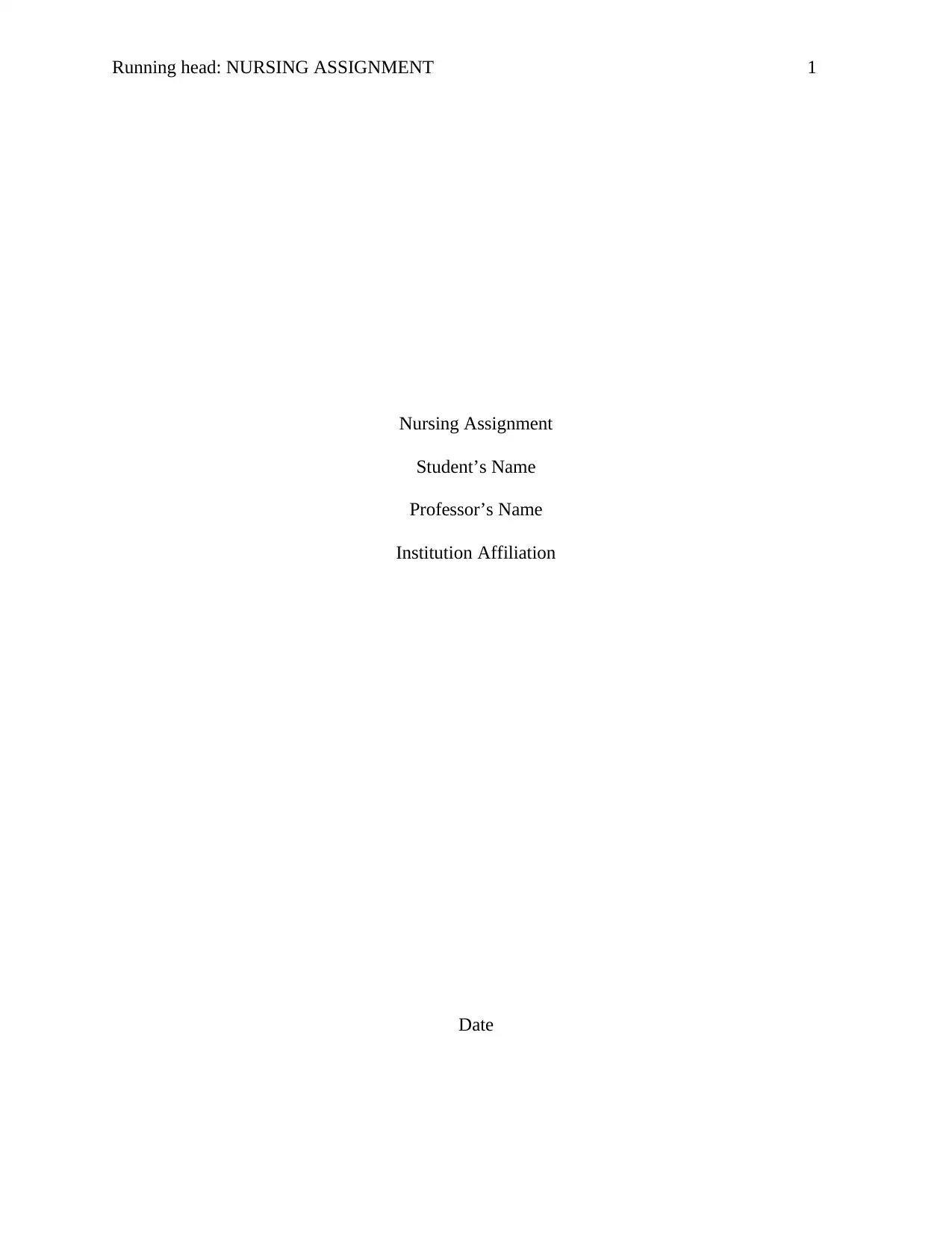
Running head: NURSING ASSIGNMENT 1
Nursing Assignment
Student’s Name
Professor’s Name
Institution Affiliation
Date
Nursing Assignment
Student’s Name
Professor’s Name
Institution Affiliation
Date
Secure Best Marks with AI Grader
Need help grading? Try our AI Grader for instant feedback on your assignments.
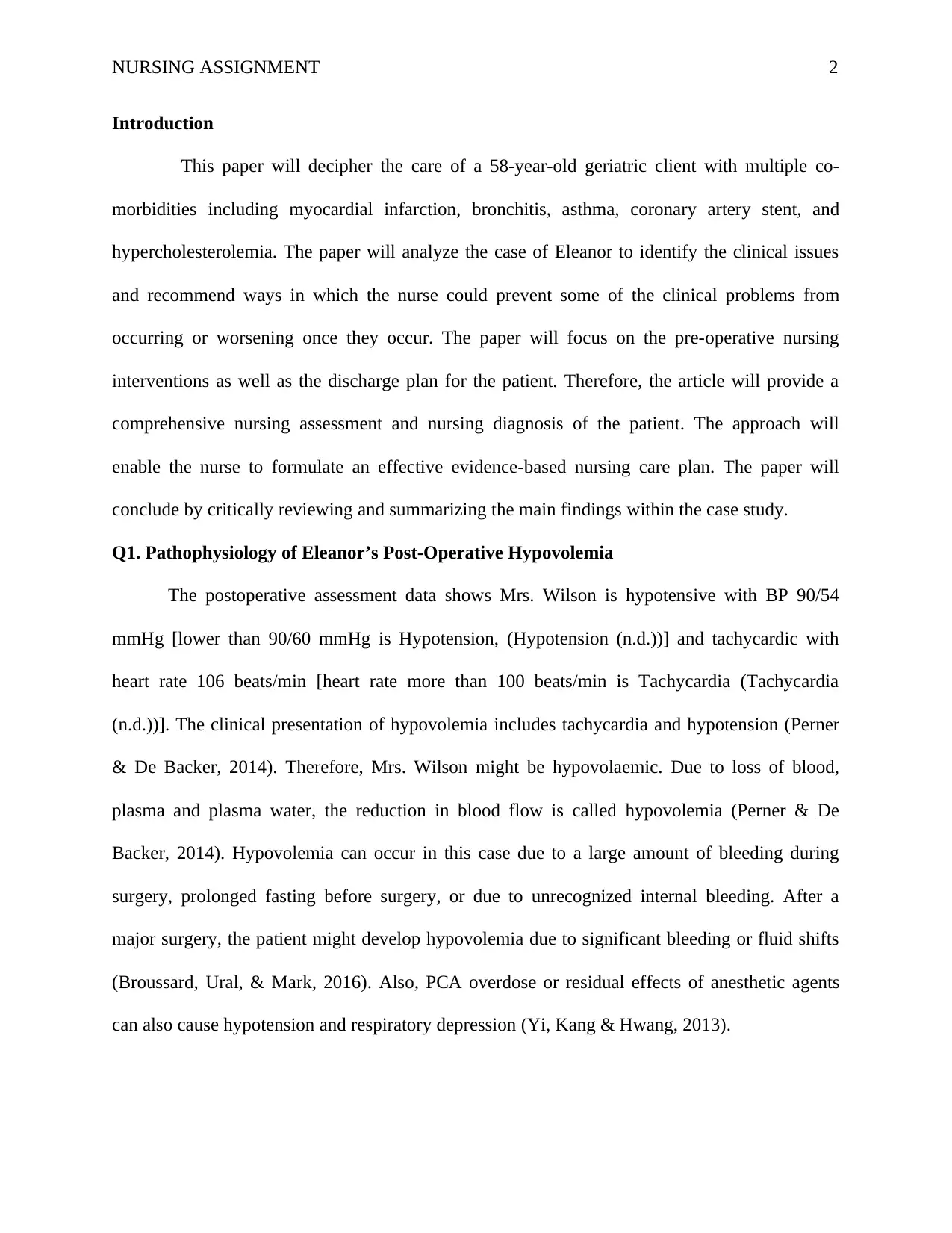
NURSING ASSIGNMENT 2
Introduction
This paper will decipher the care of a 58-year-old geriatric client with multiple co-
morbidities including myocardial infarction, bronchitis, asthma, coronary artery stent, and
hypercholesterolemia. The paper will analyze the case of Eleanor to identify the clinical issues
and recommend ways in which the nurse could prevent some of the clinical problems from
occurring or worsening once they occur. The paper will focus on the pre-operative nursing
interventions as well as the discharge plan for the patient. Therefore, the article will provide a
comprehensive nursing assessment and nursing diagnosis of the patient. The approach will
enable the nurse to formulate an effective evidence-based nursing care plan. The paper will
conclude by critically reviewing and summarizing the main findings within the case study.
Q1. Pathophysiology of Eleanor’s Post-Operative Hypovolemia
The postoperative assessment data shows Mrs. Wilson is hypotensive with BP 90/54
mmHg [lower than 90/60 mmHg is Hypotension, (Hypotension (n.d.))] and tachycardic with
heart rate 106 beats/min [heart rate more than 100 beats/min is Tachycardia (Tachycardia
(n.d.))]. The clinical presentation of hypovolemia includes tachycardia and hypotension (Perner
& De Backer, 2014). Therefore, Mrs. Wilson might be hypovolaemic. Due to loss of blood,
plasma and plasma water, the reduction in blood flow is called hypovolemia (Perner & De
Backer, 2014). Hypovolemia can occur in this case due to a large amount of bleeding during
surgery, prolonged fasting before surgery, or due to unrecognized internal bleeding. After a
major surgery, the patient might develop hypovolemia due to significant bleeding or fluid shifts
(Broussard, Ural, & Mark, 2016). Also, PCA overdose or residual effects of anesthetic agents
can also cause hypotension and respiratory depression (Yi, Kang & Hwang, 2013).
Introduction
This paper will decipher the care of a 58-year-old geriatric client with multiple co-
morbidities including myocardial infarction, bronchitis, asthma, coronary artery stent, and
hypercholesterolemia. The paper will analyze the case of Eleanor to identify the clinical issues
and recommend ways in which the nurse could prevent some of the clinical problems from
occurring or worsening once they occur. The paper will focus on the pre-operative nursing
interventions as well as the discharge plan for the patient. Therefore, the article will provide a
comprehensive nursing assessment and nursing diagnosis of the patient. The approach will
enable the nurse to formulate an effective evidence-based nursing care plan. The paper will
conclude by critically reviewing and summarizing the main findings within the case study.
Q1. Pathophysiology of Eleanor’s Post-Operative Hypovolemia
The postoperative assessment data shows Mrs. Wilson is hypotensive with BP 90/54
mmHg [lower than 90/60 mmHg is Hypotension, (Hypotension (n.d.))] and tachycardic with
heart rate 106 beats/min [heart rate more than 100 beats/min is Tachycardia (Tachycardia
(n.d.))]. The clinical presentation of hypovolemia includes tachycardia and hypotension (Perner
& De Backer, 2014). Therefore, Mrs. Wilson might be hypovolaemic. Due to loss of blood,
plasma and plasma water, the reduction in blood flow is called hypovolemia (Perner & De
Backer, 2014). Hypovolemia can occur in this case due to a large amount of bleeding during
surgery, prolonged fasting before surgery, or due to unrecognized internal bleeding. After a
major surgery, the patient might develop hypovolemia due to significant bleeding or fluid shifts
(Broussard, Ural, & Mark, 2016). Also, PCA overdose or residual effects of anesthetic agents
can also cause hypotension and respiratory depression (Yi, Kang & Hwang, 2013).
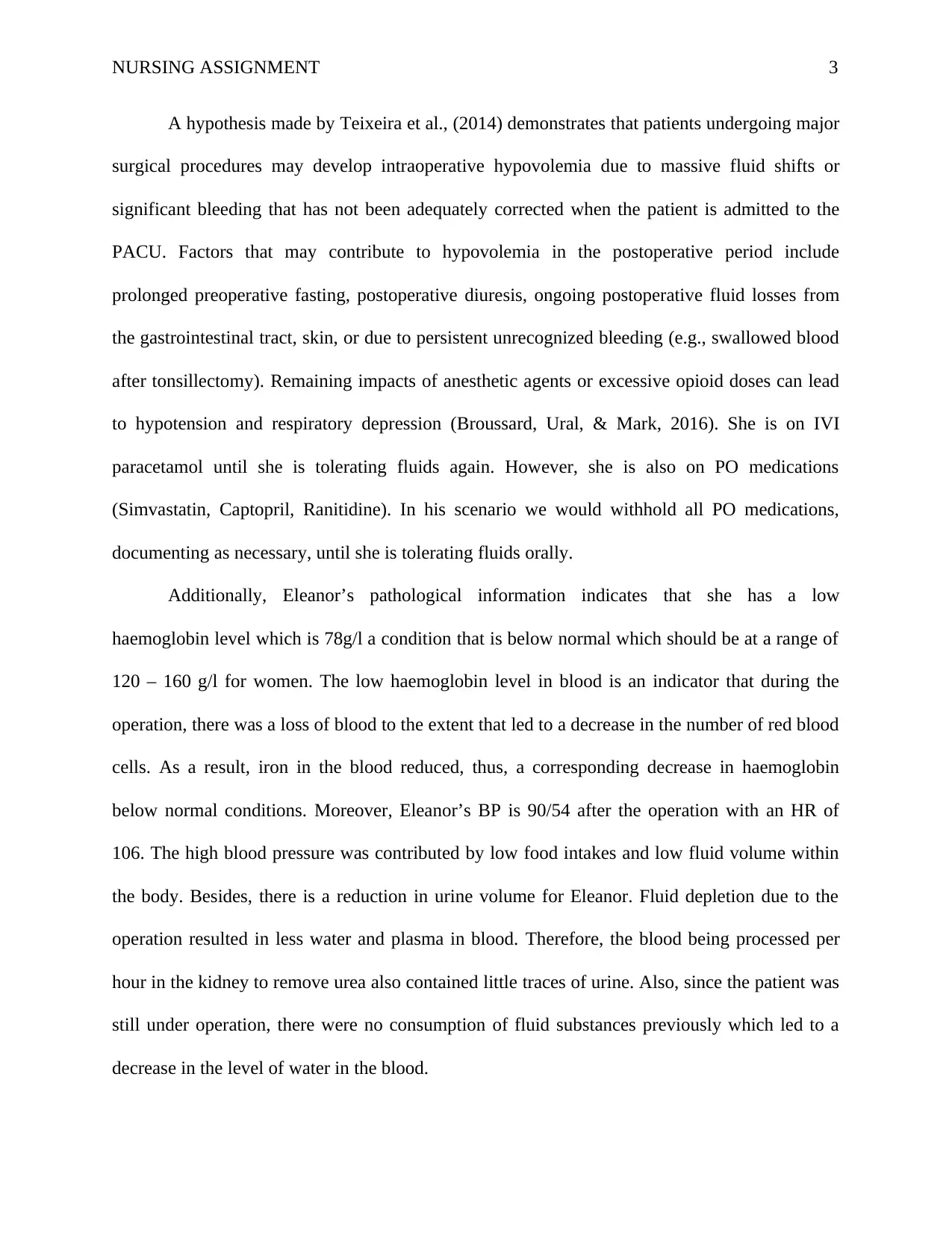
NURSING ASSIGNMENT 3
A hypothesis made by Teixeira et al., (2014) demonstrates that patients undergoing major
surgical procedures may develop intraoperative hypovolemia due to massive fluid shifts or
significant bleeding that has not been adequately corrected when the patient is admitted to the
PACU. Factors that may contribute to hypovolemia in the postoperative period include
prolonged preoperative fasting, postoperative diuresis, ongoing postoperative fluid losses from
the gastrointestinal tract, skin, or due to persistent unrecognized bleeding (e.g., swallowed blood
after tonsillectomy). Remaining impacts of anesthetic agents or excessive opioid doses can lead
to hypotension and respiratory depression (Broussard, Ural, & Mark, 2016). She is on IVI
paracetamol until she is tolerating fluids again. However, she is also on PO medications
(Simvastatin, Captopril, Ranitidine). In his scenario we would withhold all PO medications,
documenting as necessary, until she is tolerating fluids orally.
Additionally, Eleanor’s pathological information indicates that she has a low
haemoglobin level which is 78g/l a condition that is below normal which should be at a range of
120 – 160 g/l for women. The low haemoglobin level in blood is an indicator that during the
operation, there was a loss of blood to the extent that led to a decrease in the number of red blood
cells. As a result, iron in the blood reduced, thus, a corresponding decrease in haemoglobin
below normal conditions. Moreover, Eleanor’s BP is 90/54 after the operation with an HR of
106. The high blood pressure was contributed by low food intakes and low fluid volume within
the body. Besides, there is a reduction in urine volume for Eleanor. Fluid depletion due to the
operation resulted in less water and plasma in blood. Therefore, the blood being processed per
hour in the kidney to remove urea also contained little traces of urine. Also, since the patient was
still under operation, there were no consumption of fluid substances previously which led to a
decrease in the level of water in the blood.
A hypothesis made by Teixeira et al., (2014) demonstrates that patients undergoing major
surgical procedures may develop intraoperative hypovolemia due to massive fluid shifts or
significant bleeding that has not been adequately corrected when the patient is admitted to the
PACU. Factors that may contribute to hypovolemia in the postoperative period include
prolonged preoperative fasting, postoperative diuresis, ongoing postoperative fluid losses from
the gastrointestinal tract, skin, or due to persistent unrecognized bleeding (e.g., swallowed blood
after tonsillectomy). Remaining impacts of anesthetic agents or excessive opioid doses can lead
to hypotension and respiratory depression (Broussard, Ural, & Mark, 2016). She is on IVI
paracetamol until she is tolerating fluids again. However, she is also on PO medications
(Simvastatin, Captopril, Ranitidine). In his scenario we would withhold all PO medications,
documenting as necessary, until she is tolerating fluids orally.
Additionally, Eleanor’s pathological information indicates that she has a low
haemoglobin level which is 78g/l a condition that is below normal which should be at a range of
120 – 160 g/l for women. The low haemoglobin level in blood is an indicator that during the
operation, there was a loss of blood to the extent that led to a decrease in the number of red blood
cells. As a result, iron in the blood reduced, thus, a corresponding decrease in haemoglobin
below normal conditions. Moreover, Eleanor’s BP is 90/54 after the operation with an HR of
106. The high blood pressure was contributed by low food intakes and low fluid volume within
the body. Besides, there is a reduction in urine volume for Eleanor. Fluid depletion due to the
operation resulted in less water and plasma in blood. Therefore, the blood being processed per
hour in the kidney to remove urea also contained little traces of urine. Also, since the patient was
still under operation, there were no consumption of fluid substances previously which led to a
decrease in the level of water in the blood.
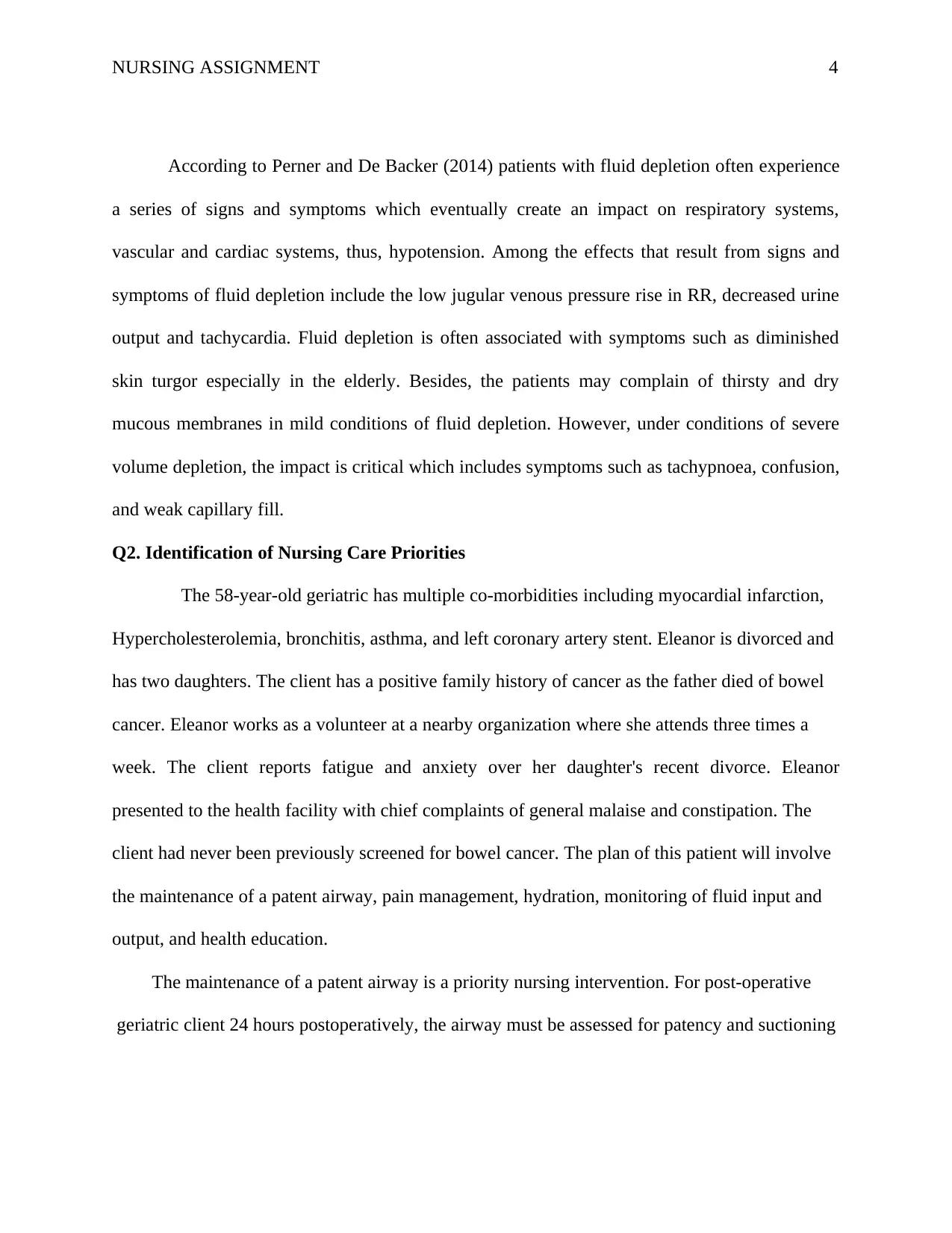
NURSING ASSIGNMENT 4
According to Perner and De Backer (2014) patients with fluid depletion often experience
a series of signs and symptoms which eventually create an impact on respiratory systems,
vascular and cardiac systems, thus, hypotension. Among the effects that result from signs and
symptoms of fluid depletion include the low jugular venous pressure rise in RR, decreased urine
output and tachycardia. Fluid depletion is often associated with symptoms such as diminished
skin turgor especially in the elderly. Besides, the patients may complain of thirsty and dry
mucous membranes in mild conditions of fluid depletion. However, under conditions of severe
volume depletion, the impact is critical which includes symptoms such as tachypnoea, confusion,
and weak capillary fill.
Q2. Identification of Nursing Care Priorities
The 58-year-old geriatric has multiple co-morbidities including myocardial infarction,
Hypercholesterolemia, bronchitis, asthma, and left coronary artery stent. Eleanor is divorced and
has two daughters. The client has a positive family history of cancer as the father died of bowel
cancer. Eleanor works as a volunteer at a nearby organization where she attends three times a
week. The client reports fatigue and anxiety over her daughter's recent divorce. Eleanor
presented to the health facility with chief complaints of general malaise and constipation. The
client had never been previously screened for bowel cancer. The plan of this patient will involve
the maintenance of a patent airway, pain management, hydration, monitoring of fluid input and
output, and health education.
The maintenance of a patent airway is a priority nursing intervention. For post-operative
geriatric client 24 hours postoperatively, the airway must be assessed for patency and suctioning
According to Perner and De Backer (2014) patients with fluid depletion often experience
a series of signs and symptoms which eventually create an impact on respiratory systems,
vascular and cardiac systems, thus, hypotension. Among the effects that result from signs and
symptoms of fluid depletion include the low jugular venous pressure rise in RR, decreased urine
output and tachycardia. Fluid depletion is often associated with symptoms such as diminished
skin turgor especially in the elderly. Besides, the patients may complain of thirsty and dry
mucous membranes in mild conditions of fluid depletion. However, under conditions of severe
volume depletion, the impact is critical which includes symptoms such as tachypnoea, confusion,
and weak capillary fill.
Q2. Identification of Nursing Care Priorities
The 58-year-old geriatric has multiple co-morbidities including myocardial infarction,
Hypercholesterolemia, bronchitis, asthma, and left coronary artery stent. Eleanor is divorced and
has two daughters. The client has a positive family history of cancer as the father died of bowel
cancer. Eleanor works as a volunteer at a nearby organization where she attends three times a
week. The client reports fatigue and anxiety over her daughter's recent divorce. Eleanor
presented to the health facility with chief complaints of general malaise and constipation. The
client had never been previously screened for bowel cancer. The plan of this patient will involve
the maintenance of a patent airway, pain management, hydration, monitoring of fluid input and
output, and health education.
The maintenance of a patent airway is a priority nursing intervention. For post-operative
geriatric client 24 hours postoperatively, the airway must be assessed for patency and suctioning
Secure Best Marks with AI Grader
Need help grading? Try our AI Grader for instant feedback on your assignments.
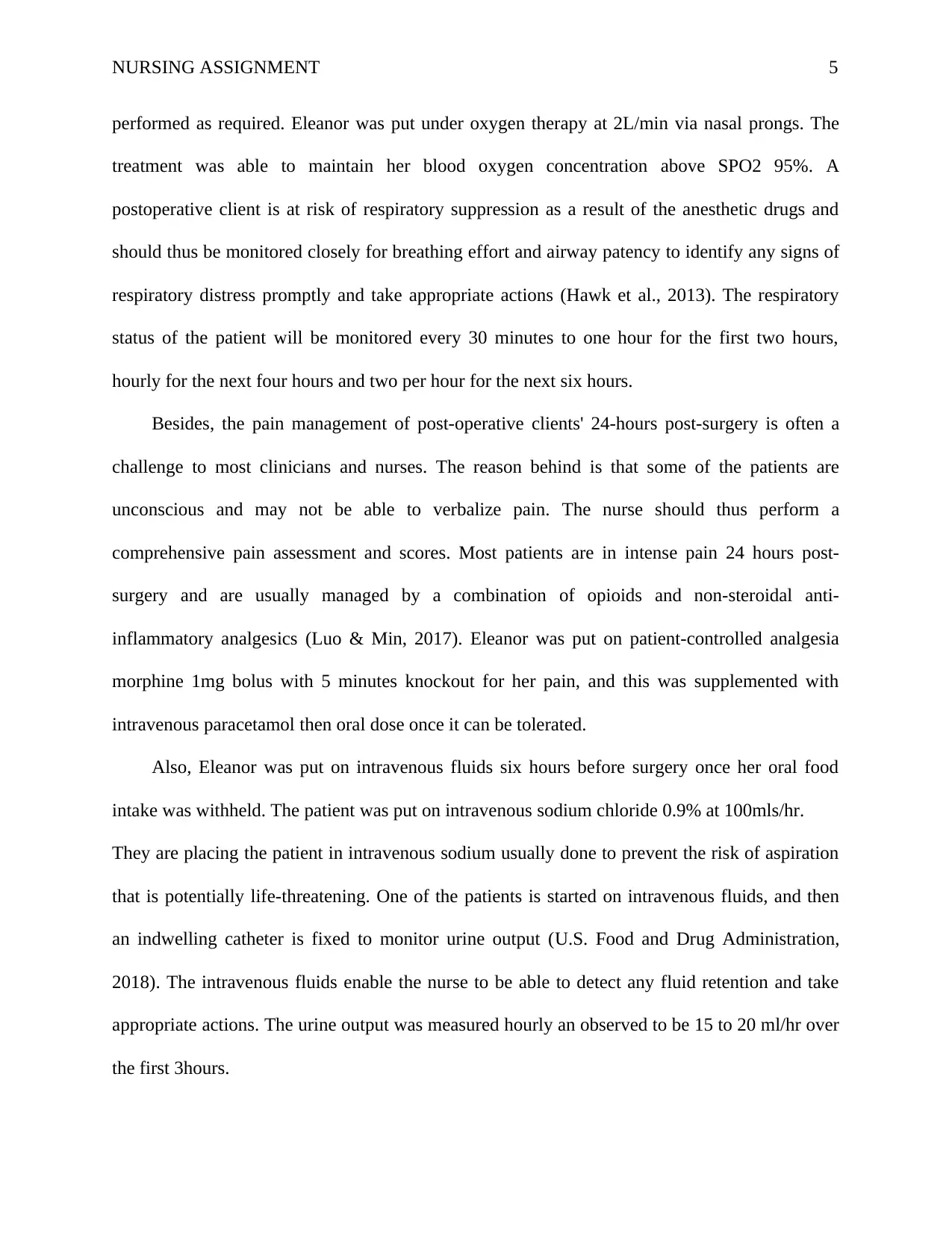
NURSING ASSIGNMENT 5
performed as required. Eleanor was put under oxygen therapy at 2L/min via nasal prongs. The
treatment was able to maintain her blood oxygen concentration above SPO2 95%. A
postoperative client is at risk of respiratory suppression as a result of the anesthetic drugs and
should thus be monitored closely for breathing effort and airway patency to identify any signs of
respiratory distress promptly and take appropriate actions (Hawk et al., 2013). The respiratory
status of the patient will be monitored every 30 minutes to one hour for the first two hours,
hourly for the next four hours and two per hour for the next six hours.
Besides, the pain management of post-operative clients' 24-hours post-surgery is often a
challenge to most clinicians and nurses. The reason behind is that some of the patients are
unconscious and may not be able to verbalize pain. The nurse should thus perform a
comprehensive pain assessment and scores. Most patients are in intense pain 24 hours post-
surgery and are usually managed by a combination of opioids and non-steroidal anti-
inflammatory analgesics (Luo & Min, 2017). Eleanor was put on patient-controlled analgesia
morphine 1mg bolus with 5 minutes knockout for her pain, and this was supplemented with
intravenous paracetamol then oral dose once it can be tolerated.
Also, Eleanor was put on intravenous fluids six hours before surgery once her oral food
intake was withheld. The patient was put on intravenous sodium chloride 0.9% at 100mls/hr.
They are placing the patient in intravenous sodium usually done to prevent the risk of aspiration
that is potentially life-threatening. One of the patients is started on intravenous fluids, and then
an indwelling catheter is fixed to monitor urine output (U.S. Food and Drug Administration,
2018). The intravenous fluids enable the nurse to be able to detect any fluid retention and take
appropriate actions. The urine output was measured hourly an observed to be 15 to 20 ml/hr over
the first 3hours.
performed as required. Eleanor was put under oxygen therapy at 2L/min via nasal prongs. The
treatment was able to maintain her blood oxygen concentration above SPO2 95%. A
postoperative client is at risk of respiratory suppression as a result of the anesthetic drugs and
should thus be monitored closely for breathing effort and airway patency to identify any signs of
respiratory distress promptly and take appropriate actions (Hawk et al., 2013). The respiratory
status of the patient will be monitored every 30 minutes to one hour for the first two hours,
hourly for the next four hours and two per hour for the next six hours.
Besides, the pain management of post-operative clients' 24-hours post-surgery is often a
challenge to most clinicians and nurses. The reason behind is that some of the patients are
unconscious and may not be able to verbalize pain. The nurse should thus perform a
comprehensive pain assessment and scores. Most patients are in intense pain 24 hours post-
surgery and are usually managed by a combination of opioids and non-steroidal anti-
inflammatory analgesics (Luo & Min, 2017). Eleanor was put on patient-controlled analgesia
morphine 1mg bolus with 5 minutes knockout for her pain, and this was supplemented with
intravenous paracetamol then oral dose once it can be tolerated.
Also, Eleanor was put on intravenous fluids six hours before surgery once her oral food
intake was withheld. The patient was put on intravenous sodium chloride 0.9% at 100mls/hr.
They are placing the patient in intravenous sodium usually done to prevent the risk of aspiration
that is potentially life-threatening. One of the patients is started on intravenous fluids, and then
an indwelling catheter is fixed to monitor urine output (U.S. Food and Drug Administration,
2018). The intravenous fluids enable the nurse to be able to detect any fluid retention and take
appropriate actions. The urine output was measured hourly an observed to be 15 to 20 ml/hr over
the first 3hours.
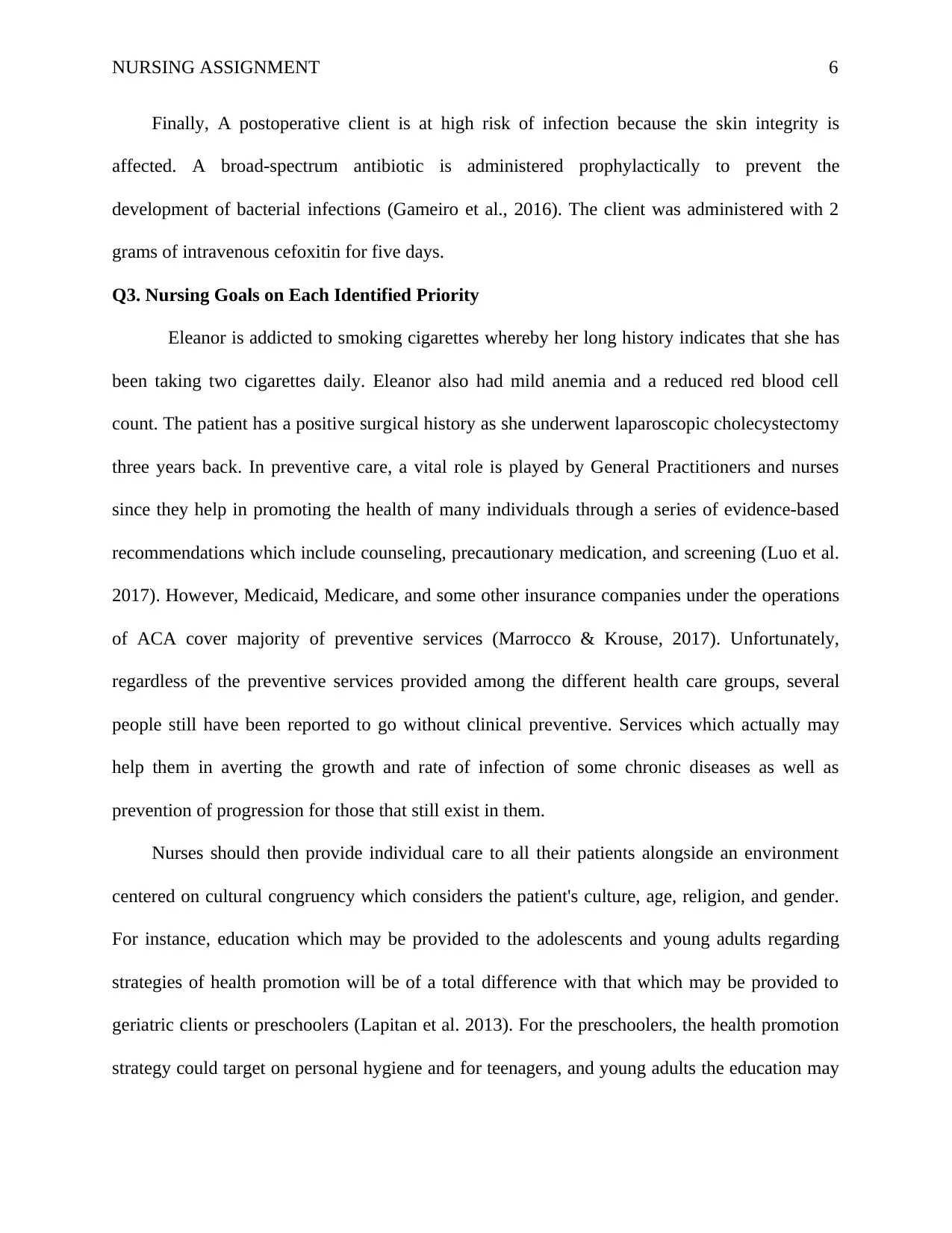
NURSING ASSIGNMENT 6
Finally, A postoperative client is at high risk of infection because the skin integrity is
affected. A broad-spectrum antibiotic is administered prophylactically to prevent the
development of bacterial infections (Gameiro et al., 2016). The client was administered with 2
grams of intravenous cefoxitin for five days.
Q3. Nursing Goals on Each Identified Priority
Eleanor is addicted to smoking cigarettes whereby her long history indicates that she has
been taking two cigarettes daily. Eleanor also had mild anemia and a reduced red blood cell
count. The patient has a positive surgical history as she underwent laparoscopic cholecystectomy
three years back. In preventive care, a vital role is played by General Practitioners and nurses
since they help in promoting the health of many individuals through a series of evidence-based
recommendations which include counseling, precautionary medication, and screening (Luo et al.
2017). However, Medicaid, Medicare, and some other insurance companies under the operations
of ACA cover majority of preventive services (Marrocco & Krouse, 2017). Unfortunately,
regardless of the preventive services provided among the different health care groups, several
people still have been reported to go without clinical preventive. Services which actually may
help them in averting the growth and rate of infection of some chronic diseases as well as
prevention of progression for those that still exist in them.
Nurses should then provide individual care to all their patients alongside an environment
centered on cultural congruency which considers the patient's culture, age, religion, and gender.
For instance, education which may be provided to the adolescents and young adults regarding
strategies of health promotion will be of a total difference with that which may be provided to
geriatric clients or preschoolers (Lapitan et al. 2013). For the preschoolers, the health promotion
strategy could target on personal hygiene and for teenagers, and young adults the education may
Finally, A postoperative client is at high risk of infection because the skin integrity is
affected. A broad-spectrum antibiotic is administered prophylactically to prevent the
development of bacterial infections (Gameiro et al., 2016). The client was administered with 2
grams of intravenous cefoxitin for five days.
Q3. Nursing Goals on Each Identified Priority
Eleanor is addicted to smoking cigarettes whereby her long history indicates that she has
been taking two cigarettes daily. Eleanor also had mild anemia and a reduced red blood cell
count. The patient has a positive surgical history as she underwent laparoscopic cholecystectomy
three years back. In preventive care, a vital role is played by General Practitioners and nurses
since they help in promoting the health of many individuals through a series of evidence-based
recommendations which include counseling, precautionary medication, and screening (Luo et al.
2017). However, Medicaid, Medicare, and some other insurance companies under the operations
of ACA cover majority of preventive services (Marrocco & Krouse, 2017). Unfortunately,
regardless of the preventive services provided among the different health care groups, several
people still have been reported to go without clinical preventive. Services which actually may
help them in averting the growth and rate of infection of some chronic diseases as well as
prevention of progression for those that still exist in them.
Nurses should then provide individual care to all their patients alongside an environment
centered on cultural congruency which considers the patient's culture, age, religion, and gender.
For instance, education which may be provided to the adolescents and young adults regarding
strategies of health promotion will be of a total difference with that which may be provided to
geriatric clients or preschoolers (Lapitan et al. 2013). For the preschoolers, the health promotion
strategy could target on personal hygiene and for teenagers, and young adults the education may
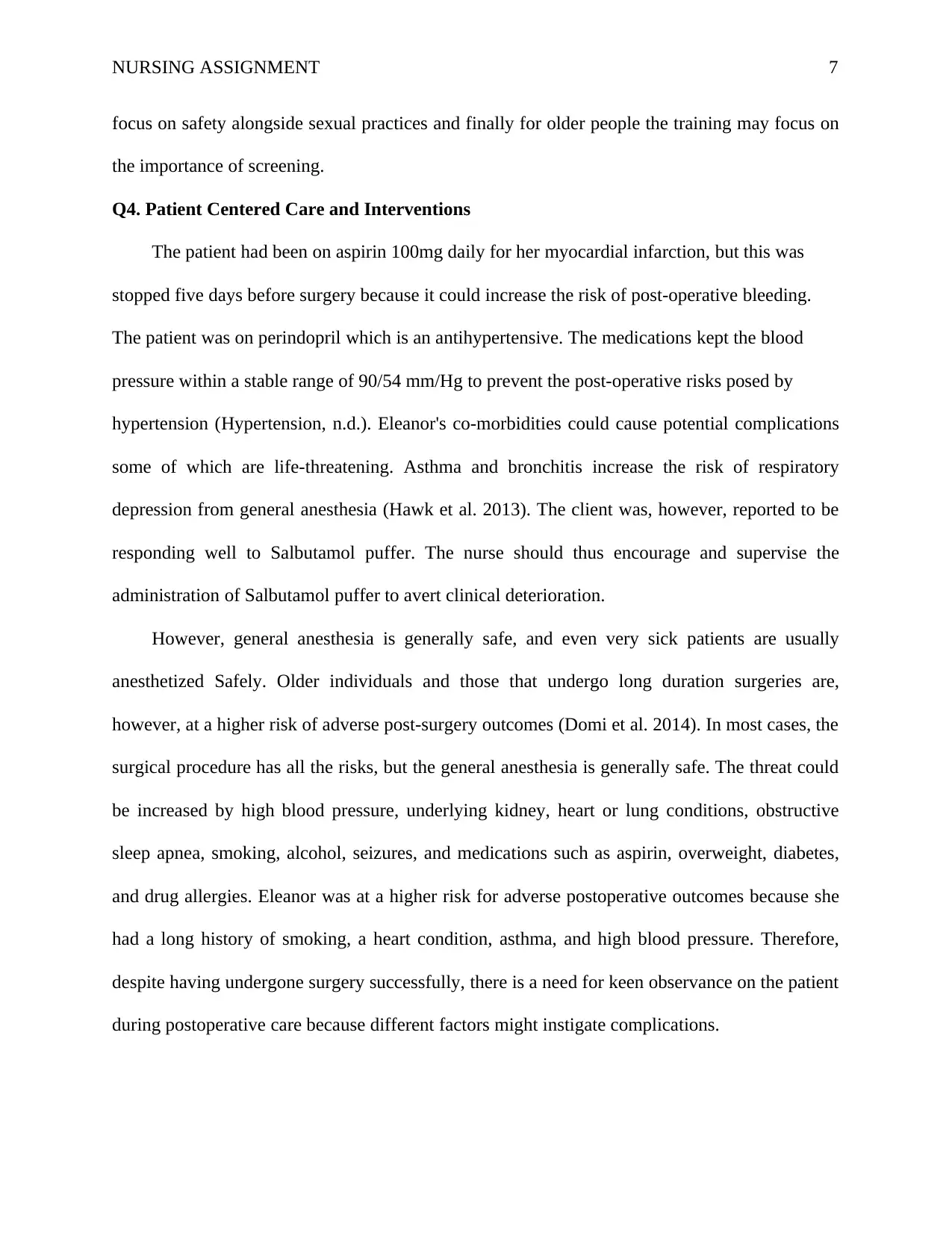
NURSING ASSIGNMENT 7
focus on safety alongside sexual practices and finally for older people the training may focus on
the importance of screening.
Q4. Patient Centered Care and Interventions
The patient had been on aspirin 100mg daily for her myocardial infarction, but this was
stopped five days before surgery because it could increase the risk of post-operative bleeding.
The patient was on perindopril which is an antihypertensive. The medications kept the blood
pressure within a stable range of 90/54 mm/Hg to prevent the post-operative risks posed by
hypertension (Hypertension, n.d.). Eleanor's co-morbidities could cause potential complications
some of which are life-threatening. Asthma and bronchitis increase the risk of respiratory
depression from general anesthesia (Hawk et al. 2013). The client was, however, reported to be
responding well to Salbutamol puffer. The nurse should thus encourage and supervise the
administration of Salbutamol puffer to avert clinical deterioration.
However, general anesthesia is generally safe, and even very sick patients are usually
anesthetized Safely. Older individuals and those that undergo long duration surgeries are,
however, at a higher risk of adverse post-surgery outcomes (Domi et al. 2014). In most cases, the
surgical procedure has all the risks, but the general anesthesia is generally safe. The threat could
be increased by high blood pressure, underlying kidney, heart or lung conditions, obstructive
sleep apnea, smoking, alcohol, seizures, and medications such as aspirin, overweight, diabetes,
and drug allergies. Eleanor was at a higher risk for adverse postoperative outcomes because she
had a long history of smoking, a heart condition, asthma, and high blood pressure. Therefore,
despite having undergone surgery successfully, there is a need for keen observance on the patient
during postoperative care because different factors might instigate complications.
focus on safety alongside sexual practices and finally for older people the training may focus on
the importance of screening.
Q4. Patient Centered Care and Interventions
The patient had been on aspirin 100mg daily for her myocardial infarction, but this was
stopped five days before surgery because it could increase the risk of post-operative bleeding.
The patient was on perindopril which is an antihypertensive. The medications kept the blood
pressure within a stable range of 90/54 mm/Hg to prevent the post-operative risks posed by
hypertension (Hypertension, n.d.). Eleanor's co-morbidities could cause potential complications
some of which are life-threatening. Asthma and bronchitis increase the risk of respiratory
depression from general anesthesia (Hawk et al. 2013). The client was, however, reported to be
responding well to Salbutamol puffer. The nurse should thus encourage and supervise the
administration of Salbutamol puffer to avert clinical deterioration.
However, general anesthesia is generally safe, and even very sick patients are usually
anesthetized Safely. Older individuals and those that undergo long duration surgeries are,
however, at a higher risk of adverse post-surgery outcomes (Domi et al. 2014). In most cases, the
surgical procedure has all the risks, but the general anesthesia is generally safe. The threat could
be increased by high blood pressure, underlying kidney, heart or lung conditions, obstructive
sleep apnea, smoking, alcohol, seizures, and medications such as aspirin, overweight, diabetes,
and drug allergies. Eleanor was at a higher risk for adverse postoperative outcomes because she
had a long history of smoking, a heart condition, asthma, and high blood pressure. Therefore,
despite having undergone surgery successfully, there is a need for keen observance on the patient
during postoperative care because different factors might instigate complications.
Paraphrase This Document
Need a fresh take? Get an instant paraphrase of this document with our AI Paraphraser
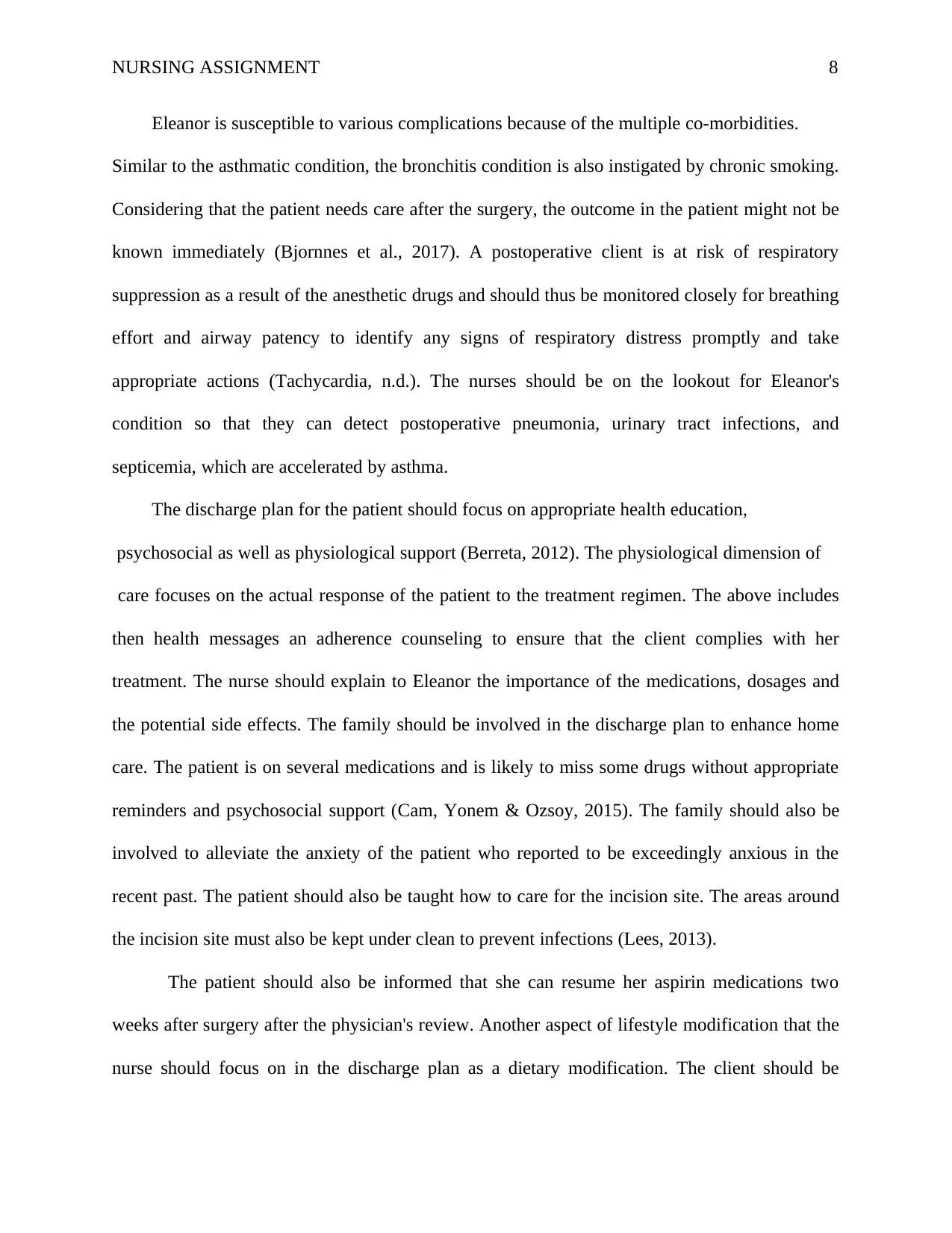
NURSING ASSIGNMENT 8
Eleanor is susceptible to various complications because of the multiple co-morbidities.
Similar to the asthmatic condition, the bronchitis condition is also instigated by chronic smoking.
Considering that the patient needs care after the surgery, the outcome in the patient might not be
known immediately (Bjornnes et al., 2017). A postoperative client is at risk of respiratory
suppression as a result of the anesthetic drugs and should thus be monitored closely for breathing
effort and airway patency to identify any signs of respiratory distress promptly and take
appropriate actions (Tachycardia, n.d.). The nurses should be on the lookout for Eleanor's
condition so that they can detect postoperative pneumonia, urinary tract infections, and
septicemia, which are accelerated by asthma.
The discharge plan for the patient should focus on appropriate health education,
psychosocial as well as physiological support (Berreta, 2012). The physiological dimension of
care focuses on the actual response of the patient to the treatment regimen. The above includes
then health messages an adherence counseling to ensure that the client complies with her
treatment. The nurse should explain to Eleanor the importance of the medications, dosages and
the potential side effects. The family should be involved in the discharge plan to enhance home
care. The patient is on several medications and is likely to miss some drugs without appropriate
reminders and psychosocial support (Cam, Yonem & Ozsoy, 2015). The family should also be
involved to alleviate the anxiety of the patient who reported to be exceedingly anxious in the
recent past. The patient should also be taught how to care for the incision site. The areas around
the incision site must also be kept under clean to prevent infections (Lees, 2013).
The patient should also be informed that she can resume her aspirin medications two
weeks after surgery after the physician's review. Another aspect of lifestyle modification that the
nurse should focus on in the discharge plan as a dietary modification. The client should be
Eleanor is susceptible to various complications because of the multiple co-morbidities.
Similar to the asthmatic condition, the bronchitis condition is also instigated by chronic smoking.
Considering that the patient needs care after the surgery, the outcome in the patient might not be
known immediately (Bjornnes et al., 2017). A postoperative client is at risk of respiratory
suppression as a result of the anesthetic drugs and should thus be monitored closely for breathing
effort and airway patency to identify any signs of respiratory distress promptly and take
appropriate actions (Tachycardia, n.d.). The nurses should be on the lookout for Eleanor's
condition so that they can detect postoperative pneumonia, urinary tract infections, and
septicemia, which are accelerated by asthma.
The discharge plan for the patient should focus on appropriate health education,
psychosocial as well as physiological support (Berreta, 2012). The physiological dimension of
care focuses on the actual response of the patient to the treatment regimen. The above includes
then health messages an adherence counseling to ensure that the client complies with her
treatment. The nurse should explain to Eleanor the importance of the medications, dosages and
the potential side effects. The family should be involved in the discharge plan to enhance home
care. The patient is on several medications and is likely to miss some drugs without appropriate
reminders and psychosocial support (Cam, Yonem & Ozsoy, 2015). The family should also be
involved to alleviate the anxiety of the patient who reported to be exceedingly anxious in the
recent past. The patient should also be taught how to care for the incision site. The areas around
the incision site must also be kept under clean to prevent infections (Lees, 2013).
The patient should also be informed that she can resume her aspirin medications two
weeks after surgery after the physician's review. Another aspect of lifestyle modification that the
nurse should focus on in the discharge plan as a dietary modification. The client should be
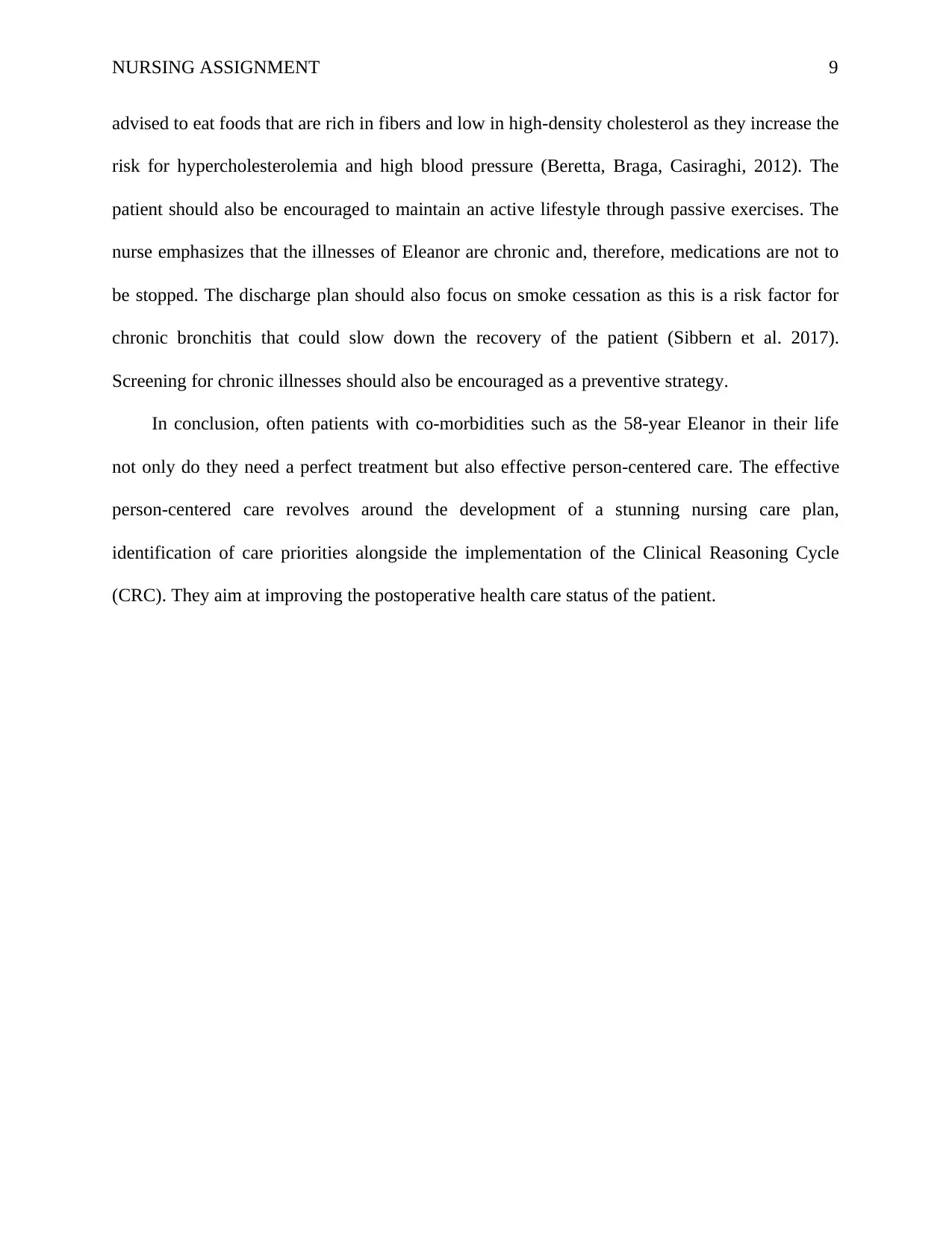
NURSING ASSIGNMENT 9
advised to eat foods that are rich in fibers and low in high-density cholesterol as they increase the
risk for hypercholesterolemia and high blood pressure (Beretta, Braga, Casiraghi, 2012). The
patient should also be encouraged to maintain an active lifestyle through passive exercises. The
nurse emphasizes that the illnesses of Eleanor are chronic and, therefore, medications are not to
be stopped. The discharge plan should also focus on smoke cessation as this is a risk factor for
chronic bronchitis that could slow down the recovery of the patient (Sibbern et al. 2017).
Screening for chronic illnesses should also be encouraged as a preventive strategy.
In conclusion, often patients with co-morbidities such as the 58-year Eleanor in their life
not only do they need a perfect treatment but also effective person-centered care. The effective
person-centered care revolves around the development of a stunning nursing care plan,
identification of care priorities alongside the implementation of the Clinical Reasoning Cycle
(CRC). They aim at improving the postoperative health care status of the patient.
advised to eat foods that are rich in fibers and low in high-density cholesterol as they increase the
risk for hypercholesterolemia and high blood pressure (Beretta, Braga, Casiraghi, 2012). The
patient should also be encouraged to maintain an active lifestyle through passive exercises. The
nurse emphasizes that the illnesses of Eleanor are chronic and, therefore, medications are not to
be stopped. The discharge plan should also focus on smoke cessation as this is a risk factor for
chronic bronchitis that could slow down the recovery of the patient (Sibbern et al. 2017).
Screening for chronic illnesses should also be encouraged as a preventive strategy.
In conclusion, often patients with co-morbidities such as the 58-year Eleanor in their life
not only do they need a perfect treatment but also effective person-centered care. The effective
person-centered care revolves around the development of a stunning nursing care plan,
identification of care priorities alongside the implementation of the Clinical Reasoning Cycle
(CRC). They aim at improving the postoperative health care status of the patient.
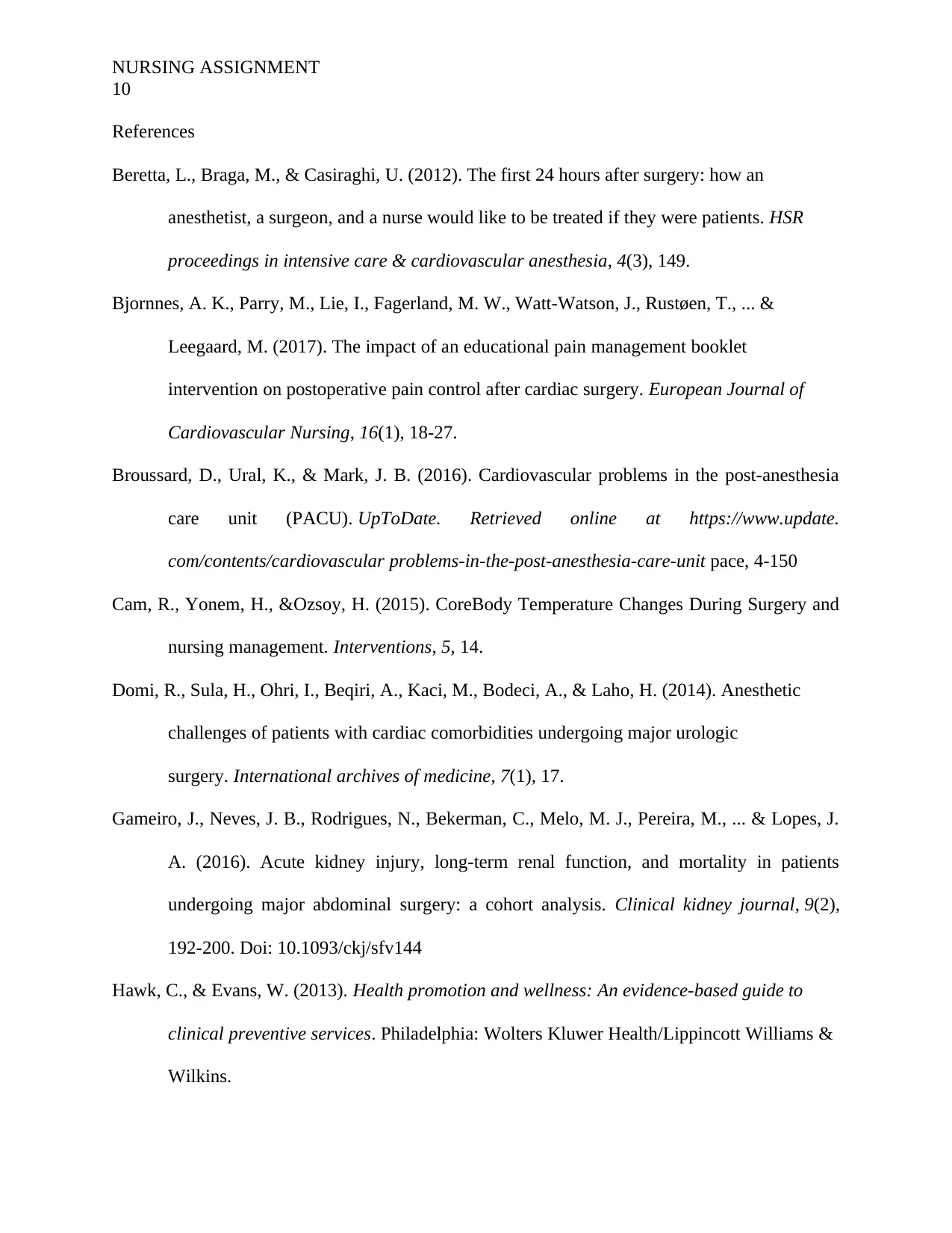
NURSING ASSIGNMENT
10
References
Beretta, L., Braga, M., & Casiraghi, U. (2012). The first 24 hours after surgery: how an
anesthetist, a surgeon, and a nurse would like to be treated if they were patients. HSR
proceedings in intensive care & cardiovascular anesthesia, 4(3), 149.
Bjornnes, A. K., Parry, M., Lie, I., Fagerland, M. W., Watt-Watson, J., Rustøen, T., ... &
Leegaard, M. (2017). The impact of an educational pain management booklet
intervention on postoperative pain control after cardiac surgery. European Journal of
Cardiovascular Nursing, 16(1), 18-27.
Broussard, D., Ural, K., & Mark, J. B. (2016). Cardiovascular problems in the post-anesthesia
care unit (PACU). UpToDate. Retrieved online at https://www.update.
com/contents/cardiovascular problems-in-the-post-anesthesia-care-unit pace, 4-150
Cam, R., Yonem, H., &Ozsoy, H. (2015). CoreBody Temperature Changes During Surgery and
nursing management. Interventions, 5, 14.
Domi, R., Sula, H., Ohri, I., Beqiri, A., Kaci, M., Bodeci, A., & Laho, H. (2014). Anesthetic
challenges of patients with cardiac comorbidities undergoing major urologic
surgery. International archives of medicine, 7(1), 17.
Gameiro, J., Neves, J. B., Rodrigues, N., Bekerman, C., Melo, M. J., Pereira, M., ... & Lopes, J.
A. (2016). Acute kidney injury, long-term renal function, and mortality in patients
undergoing major abdominal surgery: a cohort analysis. Clinical kidney journal, 9(2),
192-200. Doi: 10.1093/ckj/sfv144
Hawk, C., & Evans, W. (2013). Health promotion and wellness: An evidence-based guide to
clinical preventive services. Philadelphia: Wolters Kluwer Health/Lippincott Williams &
Wilkins.
10
References
Beretta, L., Braga, M., & Casiraghi, U. (2012). The first 24 hours after surgery: how an
anesthetist, a surgeon, and a nurse would like to be treated if they were patients. HSR
proceedings in intensive care & cardiovascular anesthesia, 4(3), 149.
Bjornnes, A. K., Parry, M., Lie, I., Fagerland, M. W., Watt-Watson, J., Rustøen, T., ... &
Leegaard, M. (2017). The impact of an educational pain management booklet
intervention on postoperative pain control after cardiac surgery. European Journal of
Cardiovascular Nursing, 16(1), 18-27.
Broussard, D., Ural, K., & Mark, J. B. (2016). Cardiovascular problems in the post-anesthesia
care unit (PACU). UpToDate. Retrieved online at https://www.update.
com/contents/cardiovascular problems-in-the-post-anesthesia-care-unit pace, 4-150
Cam, R., Yonem, H., &Ozsoy, H. (2015). CoreBody Temperature Changes During Surgery and
nursing management. Interventions, 5, 14.
Domi, R., Sula, H., Ohri, I., Beqiri, A., Kaci, M., Bodeci, A., & Laho, H. (2014). Anesthetic
challenges of patients with cardiac comorbidities undergoing major urologic
surgery. International archives of medicine, 7(1), 17.
Gameiro, J., Neves, J. B., Rodrigues, N., Bekerman, C., Melo, M. J., Pereira, M., ... & Lopes, J.
A. (2016). Acute kidney injury, long-term renal function, and mortality in patients
undergoing major abdominal surgery: a cohort analysis. Clinical kidney journal, 9(2),
192-200. Doi: 10.1093/ckj/sfv144
Hawk, C., & Evans, W. (2013). Health promotion and wellness: An evidence-based guide to
clinical preventive services. Philadelphia: Wolters Kluwer Health/Lippincott Williams &
Wilkins.
Secure Best Marks with AI Grader
Need help grading? Try our AI Grader for instant feedback on your assignments.
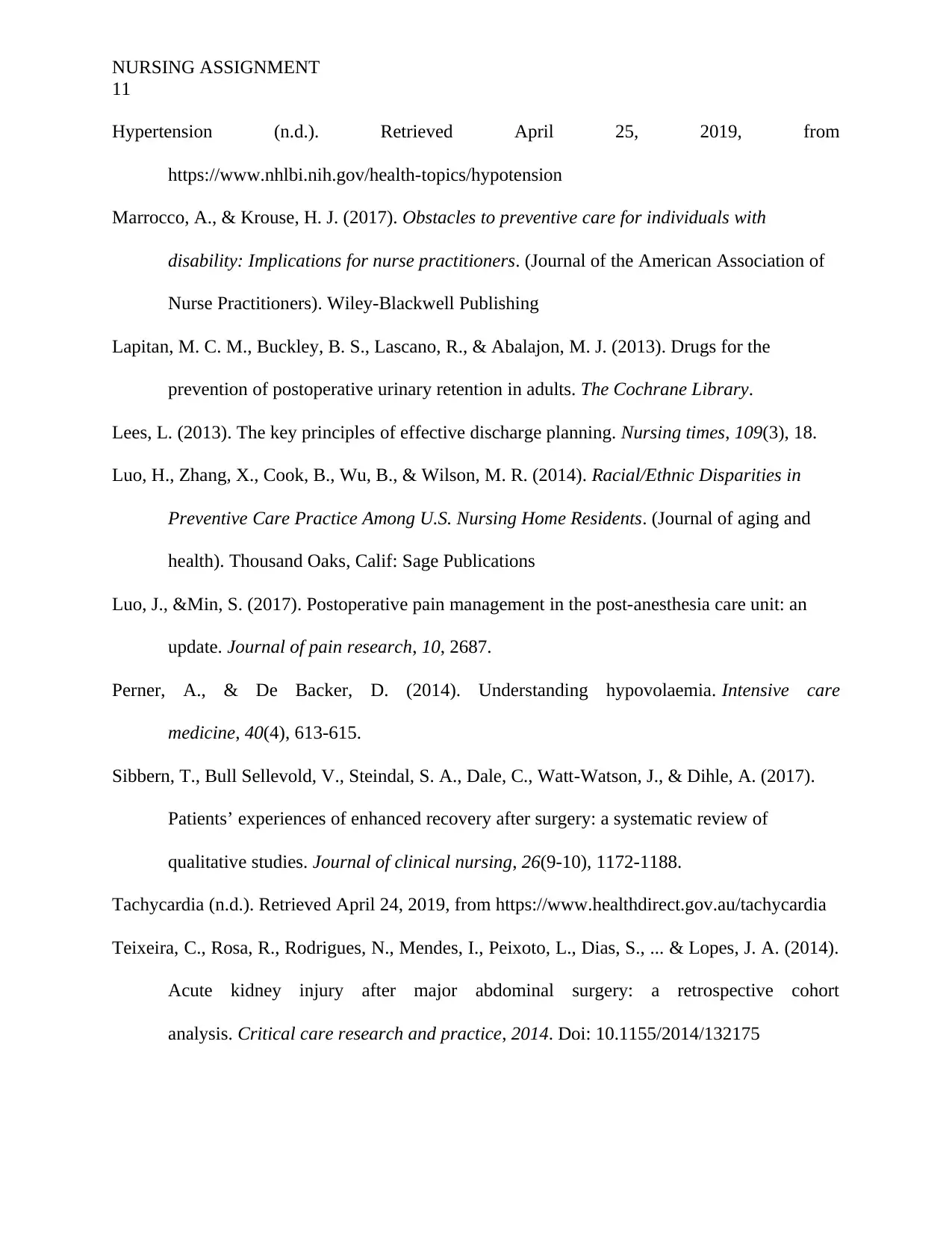
NURSING ASSIGNMENT
11
Hypertension (n.d.). Retrieved April 25, 2019, from
https://www.nhlbi.nih.gov/health-topics/hypotension
Marrocco, A., & Krouse, H. J. (2017). Obstacles to preventive care for individuals with
disability: Implications for nurse practitioners. (Journal of the American Association of
Nurse Practitioners). Wiley-Blackwell Publishing
Lapitan, M. C. M., Buckley, B. S., Lascano, R., & Abalajon, M. J. (2013). Drugs for the
prevention of postoperative urinary retention in adults. The Cochrane Library.
Lees, L. (2013). The key principles of effective discharge planning. Nursing times, 109(3), 18.
Luo, H., Zhang, X., Cook, B., Wu, B., & Wilson, M. R. (2014). Racial/Ethnic Disparities in
Preventive Care Practice Among U.S. Nursing Home Residents. (Journal of aging and
health). Thousand Oaks, Calif: Sage Publications
Luo, J., &Min, S. (2017). Postoperative pain management in the post-anesthesia care unit: an
update. Journal of pain research, 10, 2687.
Perner, A., & De Backer, D. (2014). Understanding hypovolaemia. Intensive care
medicine, 40(4), 613-615.
Sibbern, T., Bull Sellevold, V., Steindal, S. A., Dale, C., Watt‐Watson, J., & Dihle, A. (2017).
Patients’ experiences of enhanced recovery after surgery: a systematic review of
qualitative studies. Journal of clinical nursing, 26(9-10), 1172-1188.
Tachycardia (n.d.). Retrieved April 24, 2019, from https://www.healthdirect.gov.au/tachycardia
Teixeira, C., Rosa, R., Rodrigues, N., Mendes, I., Peixoto, L., Dias, S., ... & Lopes, J. A. (2014).
Acute kidney injury after major abdominal surgery: a retrospective cohort
analysis. Critical care research and practice, 2014. Doi: 10.1155/2014/132175
11
Hypertension (n.d.). Retrieved April 25, 2019, from
https://www.nhlbi.nih.gov/health-topics/hypotension
Marrocco, A., & Krouse, H. J. (2017). Obstacles to preventive care for individuals with
disability: Implications for nurse practitioners. (Journal of the American Association of
Nurse Practitioners). Wiley-Blackwell Publishing
Lapitan, M. C. M., Buckley, B. S., Lascano, R., & Abalajon, M. J. (2013). Drugs for the
prevention of postoperative urinary retention in adults. The Cochrane Library.
Lees, L. (2013). The key principles of effective discharge planning. Nursing times, 109(3), 18.
Luo, H., Zhang, X., Cook, B., Wu, B., & Wilson, M. R. (2014). Racial/Ethnic Disparities in
Preventive Care Practice Among U.S. Nursing Home Residents. (Journal of aging and
health). Thousand Oaks, Calif: Sage Publications
Luo, J., &Min, S. (2017). Postoperative pain management in the post-anesthesia care unit: an
update. Journal of pain research, 10, 2687.
Perner, A., & De Backer, D. (2014). Understanding hypovolaemia. Intensive care
medicine, 40(4), 613-615.
Sibbern, T., Bull Sellevold, V., Steindal, S. A., Dale, C., Watt‐Watson, J., & Dihle, A. (2017).
Patients’ experiences of enhanced recovery after surgery: a systematic review of
qualitative studies. Journal of clinical nursing, 26(9-10), 1172-1188.
Tachycardia (n.d.). Retrieved April 24, 2019, from https://www.healthdirect.gov.au/tachycardia
Teixeira, C., Rosa, R., Rodrigues, N., Mendes, I., Peixoto, L., Dias, S., ... & Lopes, J. A. (2014).
Acute kidney injury after major abdominal surgery: a retrospective cohort
analysis. Critical care research and practice, 2014. Doi: 10.1155/2014/132175
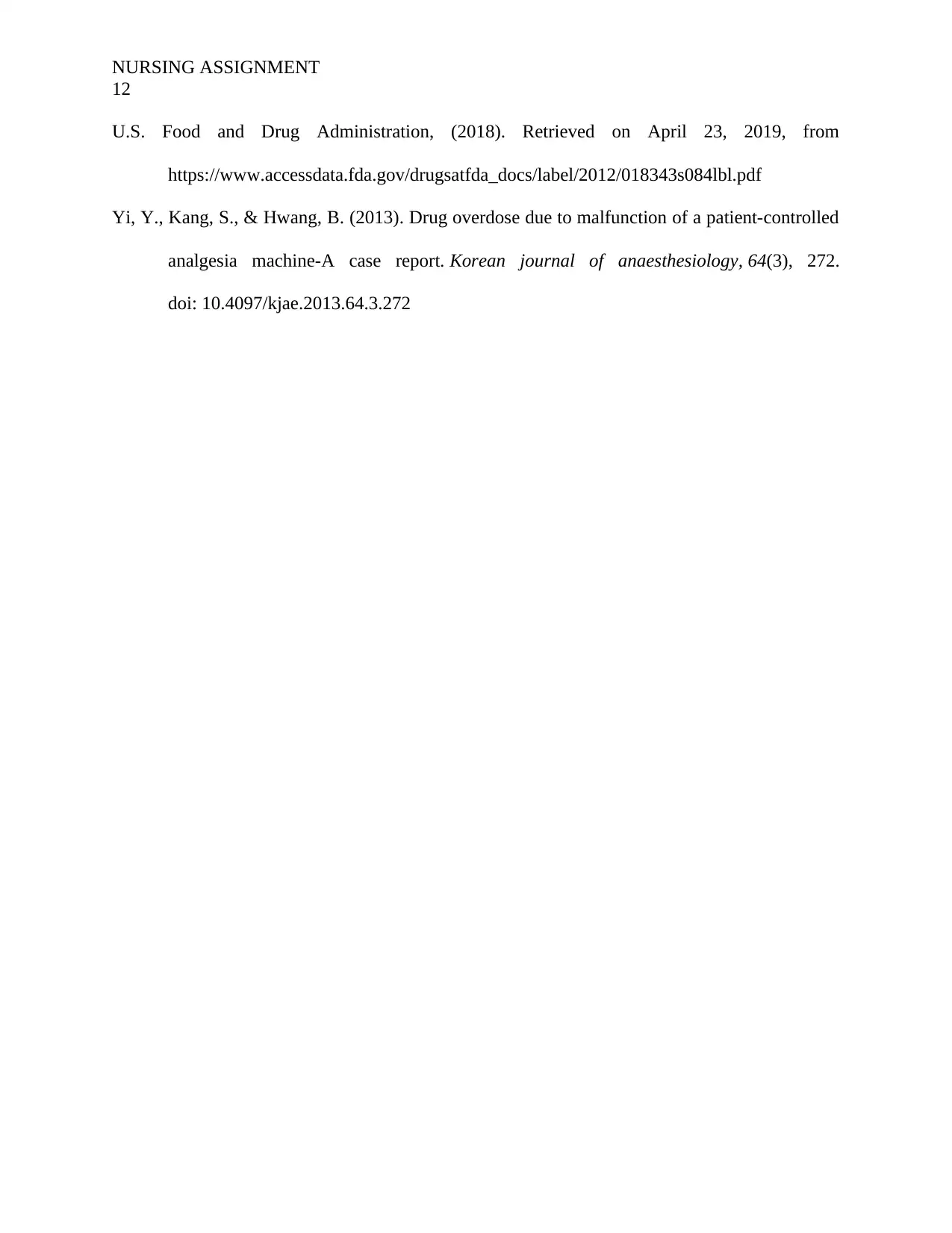
NURSING ASSIGNMENT
12
U.S. Food and Drug Administration, (2018). Retrieved on April 23, 2019, from
https://www.accessdata.fda.gov/drugsatfda_docs/label/2012/018343s084lbl.pdf
Yi, Y., Kang, S., & Hwang, B. (2013). Drug overdose due to malfunction of a patient-controlled
analgesia machine-A case report. Korean journal of anaesthesiology, 64(3), 272.
doi: 10.4097/kjae.2013.64.3.272
12
U.S. Food and Drug Administration, (2018). Retrieved on April 23, 2019, from
https://www.accessdata.fda.gov/drugsatfda_docs/label/2012/018343s084lbl.pdf
Yi, Y., Kang, S., & Hwang, B. (2013). Drug overdose due to malfunction of a patient-controlled
analgesia machine-A case report. Korean journal of anaesthesiology, 64(3), 272.
doi: 10.4097/kjae.2013.64.3.272
1 out of 12
Related Documents
Your All-in-One AI-Powered Toolkit for Academic Success.
+13062052269
info@desklib.com
Available 24*7 on WhatsApp / Email
![[object Object]](/_next/static/media/star-bottom.7253800d.svg)
Unlock your academic potential
© 2024 | Zucol Services PVT LTD | All rights reserved.
